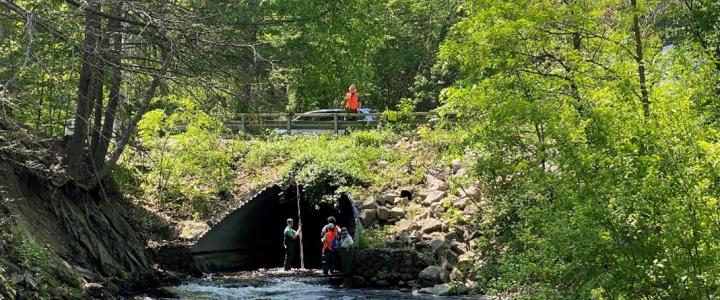
Commissioner's Column: Stream crossing assessments ramp up
Enabled by funding through the American Rescue Plan Act (ARPA), the University of New Hampshire (UNH) is working with the New Hampshire Department of Environmental Services (NHDES) and the New Hampshire Stream Crossing Initiative (NHSCI) to collect and analyze stream crossing data that will inform the prioritization of stream crossing replacements, which will enhance wildlife passage and public safety while increasing resiliency to extreme weather events. The NHSCI is a multi-agency group that collaboratively works to align resources and improve management of stream crossing infrastructure across the state.
There are over 20,000 road crossings comprised of culverts and bridges that intersect New Hampshire’s rivers, streams and wetlands. Over the summers of 2022 and 2023, UNH teams assessed over 4,000 stream crossings for geomorphic compatibility, hydraulic capacity and aquatic wildlife passage using standardized methods by the NHSCI. Thanks to this effort, all accessible stream crossings within the Merrimack River and Salmon Falls-Piscataqua River watersheds have been assessed. Previous assessment efforts led by other entities have been limited by field personnel and supervisory capacity and typically only accomplish 100 to 300 assessments per year. The complete stream crossing dataset, which currently accounts for over 70% of New Hampshire’s stream crossings (and counting!), can be accessed through NHDES’ Aquatic Restoration Mapper.
Despite a robust stream crossing data set, New Hampshire lacks a uniform stream crossing replacement prioritization process. The second phase of this UNH partnership project, which is underway, is rolling out an extensive engagement process to elicit feedback from a diverse group of stakeholders at the local and state level that can inform the development of a stream crossing prioritization model and interactive planning tool utilizing the stream crossing assessment data. The goal of the modelling effort is to identify win-win management scenarios that balance stakeholders’ needs with ecological, infrastructure, public safety and economic needs by eliciting their preferences for stream crossing optimization criteria. Stay tuned for a public survey in the coming months!




